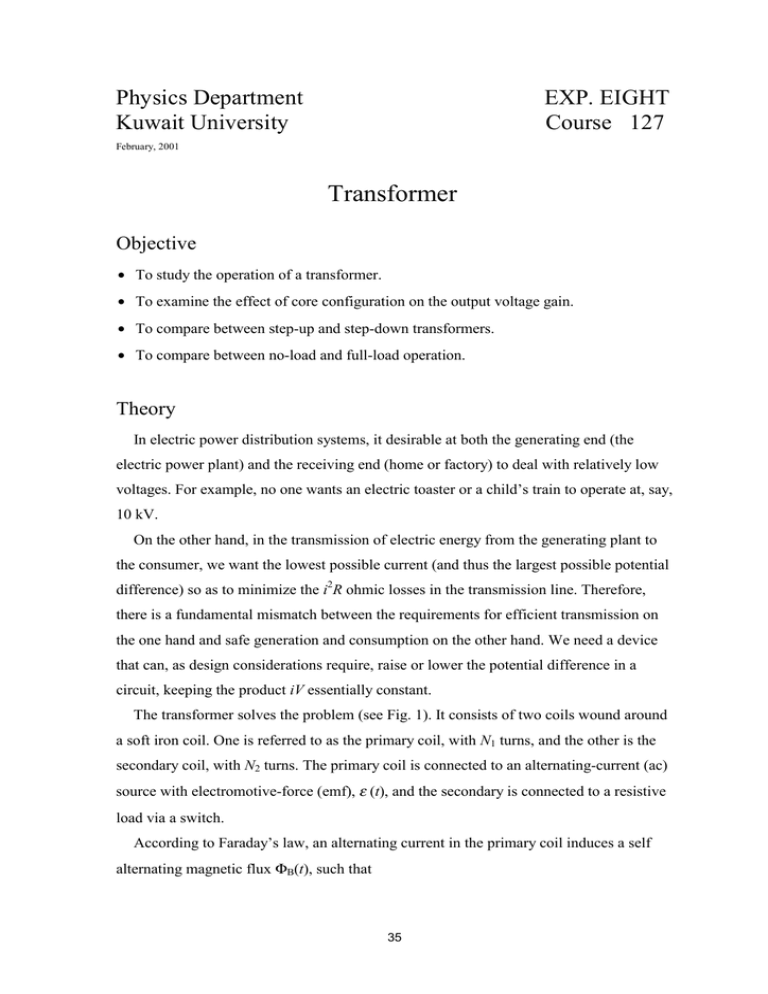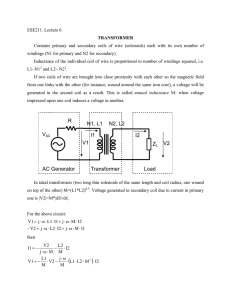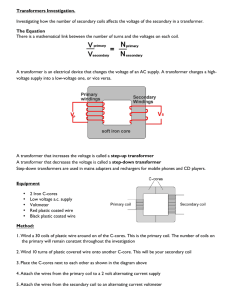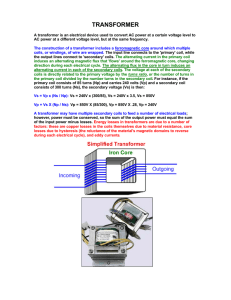Transformer - Kuniv.edu.kw
advertisement

Physics Department Kuwait University EXP. EIGHT Course 127 February, 2001 Transformer Objective • To study the operation of a transformer. • To examine the effect of core configuration on the output voltage gain. • To compare between step-up and step-down transformers. • To compare between no-load and full-load operation. Theory In electric power distribution systems, it desirable at both the generating end (the electric power plant) and the receiving end (home or factory) to deal with relatively low voltages. For example, no one wants an electric toaster or a child’s train to operate at, say, 10 kV. On the other hand, in the transmission of electric energy from the generating plant to the consumer, we want the lowest possible current (and thus the largest possible potential difference) so as to minimize the i2R ohmic losses in the transmission line. Therefore, there is a fundamental mismatch between the requirements for efficient transmission on the one hand and safe generation and consumption on the other hand. We need a device that can, as design considerations require, raise or lower the potential difference in a circuit, keeping the product iV essentially constant. The transformer solves the problem (see Fig. 1). It consists of two coils wound around a soft iron coil. One is referred to as the primary coil, with N1 turns, and the other is the secondary coil, with N2 turns. The primary coil is connected to an alternating-current (ac) source with electromotive-force (emf), ε (t), and the secondary is connected to a resistive load via a switch. According to Faraday’s law, an alternating current in the primary coil induces a self alternating magnetic flux ΦB(t), such that 35 ε = V1 = − N 1 dΦ B , dt (1) where, V1 is the potential difference developed across the primary coil. The magnetic flux ΦB(t) S ε (t) R Primary (N1) Secondary (N2) Figure 1: The basic Transformer is linked to the secondary coil through the iron core. Thus, the magnetic flux rate is the same for both coils, therefore, using Eq.(1), we get − dΦ B V1 V = = 2 , dt N1 N 2 (2) where V2 is the potential difference developed across the secondary coil, or, N V2 = V1 2 N1 . (3) Now, if N2 > N1, we speak of a step-up transformer; and if N2 > N1, we speak of a stepdown transformer. The voltage gain, G, may be defined as the ratio between the output, to the input voltages, or G= Vo . Vin (4) When the switch is open (no load operation), no current exists in the secondary coil and therefore, no power is delivered to the transformer, and the primary coil acts as a pure inductance. Whereas, if the switch is closed a current, i2, is set through the secondary coil, and the two windings appear to be as a fully coupled mutual inductance. 36 Actually, the closed switch operation is rather complex to analyze. Therefore we take advantage of the overall view provided by the conservation of energy principle. For an ideal transformer with a resistive load this tells us that Pin = Po, (5) Where Pin, and Po are the input and output powers. Transformer efficiency may be expressed as Efficiency = Po × 100 . Pin (6) In practice no transformer is of 100% efficiency due to power losses. Some of the main reasons for these losses are: the resistance of the coils, the magnetic leakage, and the hysteresis losses (due to magnetization properties of the core). Equipment • The PASCO SF-8616 Basic Coils Set. • Low voltage ac power supply 0-6 VAC, 0-1 amp such as PASCO Model SF-9582. • Resistance box. • Banana connecting leads for electrical connections. • Multimeter (2). Procedure Part one (core configuration) 1. Set up the two coils labeled 400-turn as shown in Fig. 2 (no core is used). 2. Set the voltage of the supply to 6 V. 3. Measure input and output voltages, calculate the voltage gain and record in Table I. 4. Repeat step 3, changing the core configuration as shown in Fig. 3. Part two (Step-up vs step-down transformer) 1. Using the core configuration that gave the maximum voltage gain in part 1, set up the coils as shown in Fig. 2. 2. Measure input and output voltages, calculate the voltage gain and record in Table II. 37 3. Fixing the primary coil to 400-turns, repeat step 2, changing the secondary coil according to Table II. 4. Use the 3200-turn coil as your primary, repeat step 2, changing the secondary coil as given in Table III. Record the data. Primary Secondary Figure 2: Input and output voltage measurements Iron bar U-shape Figure 3: Core configurations 38 Square-shape Table I (both coils of 400-turns) Core Vin (V) Vo (V) G NO Iron bar U-shape Square-shape Table II (step-up) Primary Secondary 400 400 400 800 400 1600 400 3200 Vin (V) Vo (V) G Vin (V) Vo (V) G Table III (step-down) Primary Secondary 3200 1600 3200 800 3200 400 3200 200 Part three (Power efficiency) 1. Using a 400-turn as the primary, and 1600-turn as secondary, set up the coils as shown in Fig. 4, using the square core configuration. 2. Set the ammeters to milli-Amp range. 3. Set the resistor to the 1000 Ω. 4. Measure the input and output voltages and currents. Record in Table IV. 5. Calculate the input and output powers, voltage gain, and the power efficiency. Record in Table V. 6. Repeat steps 4 & 5 for resister values given in the table. 39 Resistor Figure 4: Current and voltage measurements Table IV (voltages & currents) R (Ω) Vin (V) Iin (mA) Vo (V) Io (mA) Po (W) G Efficiency 1000 1100 1200 1300 1400 1500 Table V (power efficiency) R (Ω) Pin (W) 1000 1100 1200 1300 1400 1500 40 Questions 1. Explain why stepping–up the voltage in the beginning of the transmission lines, reduces the ohmic loses? 2. Which core configuration gives the maximum voltage gain? Explain? 3. When no load is connected to the secondary coil, does the transformer disipates energy? Why? 4. Is the power efficiency, that you got, equals 100%? If not, can you explain the reason? 41



